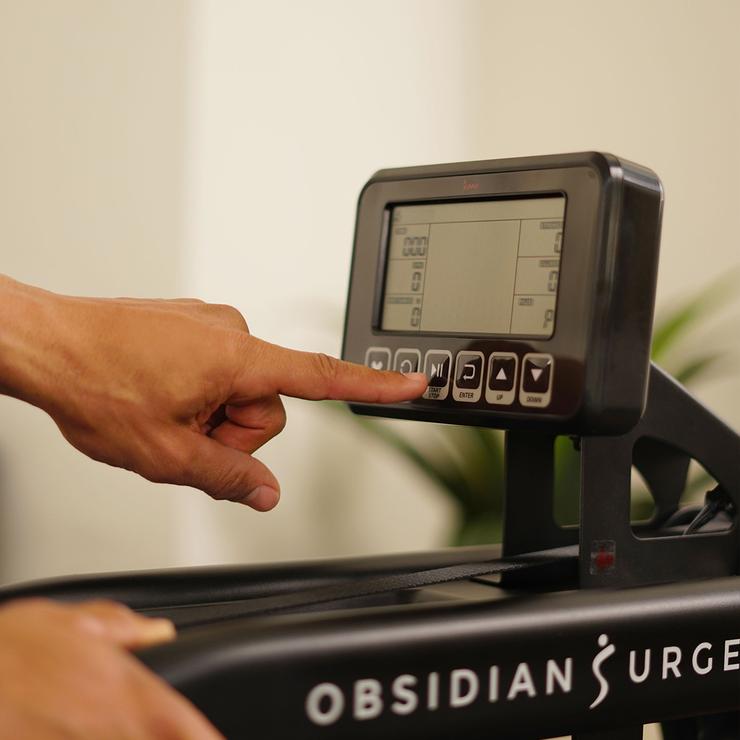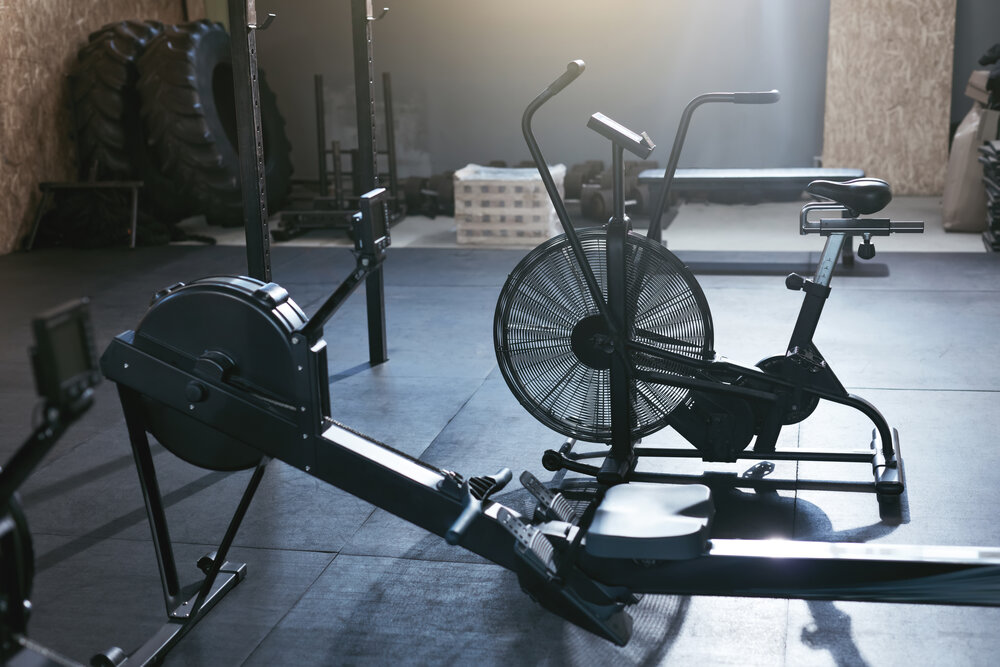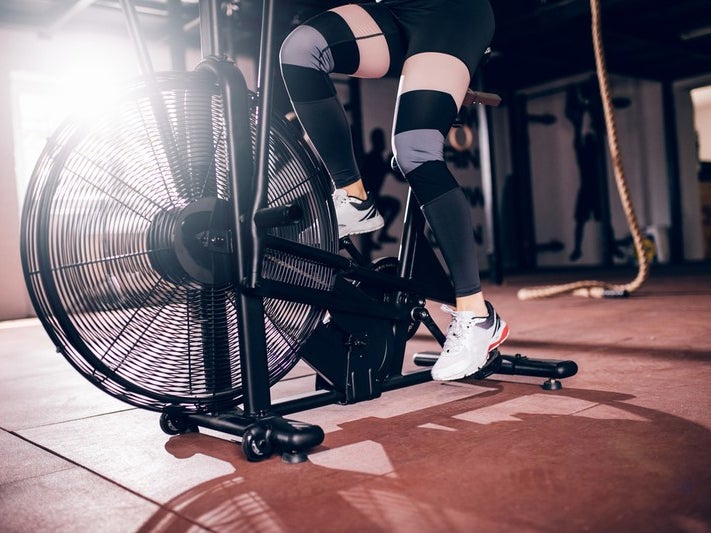Air Bikes are known for their exceptional muscle toning and calorie burning potential, and the same goes for rowing machines. In the case of Air Bike Vs Rower, how do they compare? Let’s find out!
What is an air bike?
The air bike, also called the fan bike, is a type of stationary bicycle meant for indoor based use and exercise.
They are notable for the large fan attached that generates varying amounts of wind force the harder you peddle, which is what creates the bike’s resistance.

Unlike other exercise bikes, the air bike does not have any adjustable resistance settings, buttons, or gadgets, because, as mentioned above, the resistance is determined entirely by how fast the user peddles, making the workout easy to tailor to the individual.
It is also equipped with handles that move as you peddle, aiding in working out parts of the upper body as well.
They are also known for their exceedingly high calorie burn, commonly burning anywhere from 20 to 30 calories per minute, and the record being held at 87 calories per minute!
What is a rower?
A rower also called a rowing machine or indoor rower is a type of exercise machine meant to simulate the motion and benefits of rowing a watercraft, minus the need for a boat, a paddle, or a source of water!
Rowers are known for their low impact benefits and coupled with being easy to use, makes the machine a great choice for those with joint problems such as arthritis, or those recovering from injuries.
Head to head: air bike vs rower breakdown!
It’s time to get into the real meat of this article, and that is, how do air bikes and rowers stack up and compare to each other?
Do they share similar benefits, general pros, and cons?
How do their costs reflect their high quality and popularity; can the average Joe afford either of these beasts of a machine?
Let’s get right into it!
Air bike vs rower for calorie burn
Both rowing machines and air bikes burn a lot of calories, so when considering the purchase of some new gym equipment for losing weight, either can be an excellent choice and more than satisfactory for the task.
But to be specific, let’s look into just how many calories they can burn in a session.
The air bike can burn as many as 300 calories in as little as 20 minutes of pedaling, and rowing machines are no slouch either, burning up to 200 to 300 calories in 30-minute sessions.
These details on how much the individual will burn do vary widely with the height and weight of the person using the machines, so it’s best to keep this in mind when trying to calculate your specific calorie-burning goals.
Thankfully, calorie burn calculators exist plentifully online, allowing you to input your height, weight, type of exercise, intensity, and the length of your workout session to get a firm, rough estimate on your particular stats.

The main point to remember about burning calories during exercise is that more vigorous and higher intensity workouts burn more calories and at a faster rate, with or without machinery.
Exercise equipment that tends to involve more muscle groupings that get worked on during sessions also can make a difference in how many calories, and subsequent pounds can be lost.
Also important is that the more muscle you put on, the more calories you burn, so both of these aspects combined can substantially accelerate your weight loss!
Air bike vs rower for cost-effectiveness
Everyone wants high quality and effective exercise equipment, and upon seeing the multitudes of benefits touted by rower and air bike enthusiasts, many will be tempted to hop right on the bandwagon and purchase their own without a second thought.
However, unless you’re Daddy BigBucks, budgets are an unfortunately common and realistic sticking point for the vast majority of people, especially for big-ticket items, so it’s important to consider costs when contemplating your next purchase.
In regards to the rower, the cost can vary depending on the specific type, especially ones with more “modern” features such as a built-in heart rate monitor or calorie burning tracker.
The single pull rowers tend to be on the pricier side at an average cost of generally 200 dollars or more, capping out at around 2k depending on the specific build and features, of course.

While machines that are closer to their watercraft rowing simulation origin are referred to as oar machines and generally cost upwards of anywhere from 150 to 700 dollars, making them slightly more affordable than the above type.
Air bikes, as a general rule, are more expensive, however, generally costing upwards of 700 dollars, maxing out at 3k!
While there are smaller models of bikes with a fan attached that can be purchased for under 600 dollars or so, those tend to not have as durable a build nor allow for as much intensity with exercise sessions.
Similar, but not really at all the same.
Air vs rower for user-friendliness
Both rowers and air bikes are fairly easy to use for most people, as in the rower’s case, the user grasps the ‘oar’ and pulls and pushes in a linear motion, which engages many muscles of the lower and upper body in the process.
It’s important to remember and make use of proper rowing form when using the machine though, as rowing can be a high-intensity exercise, and as such, soreness and aches are a common problem if the user hunches and uses the rower improperly.
Gripping the oar too tightly can also cause soreness and pain from increased tension in the hands and arms.
More common mistakes when using the rower also include lifting the oar too high, which puts unnecessary strain on the arms, and letting the legs and knee bend outward to the side, rather than keeping them firmly straight and in line with the hips.
The air bike is simply used by pedaling and grasping the movable handlebars as you go through the workout, making it a low strain on the body and easy to use.

Many air bike veterans note that it’s important to not overtax the arms and use them too much, but to put most of the focus of your energy on the lower body and legs for pedaling, as this prevents upper body soreness and tiring yourself out too fast.
Adjusting the seat to ensure you’re in a comfortable position is also important, as, like the rower, proper form is essential for preventing extra soreness or pain from workouts.
Keeping the ball of your foot on the pedal rather than the whole foot also aids in putting more power in your pedaling, and taking as much strain off your lower legs as possible by not overworking them with overly strenuous strides.
A neutral and straight head position focused on looking forwards is also helpful for keeping one’s form optimal, and preventing neck soreness from glancing down at monitors or other areas of the machine.
Air bike vs rower for toning and muscle building
Rowing machines are estimated to engage up to 85 percent of your muscles when the ideal form is used, making them amazing machines for building and toning muscle, which will, in turn, help you lose weight faster and more effectively.
Due to this, rowing is considered a full-body workout and an excellent way of getting and staying in shape!
Even the most relaxed rower can burn calories and get effective cardio benefits from the use of the machine, as in general, rowing is high intensity and best of all, is low impact, making it easy on the joints and body, with none of the negatives.
While air bikes may not engage as many muscle groups as the rowing machine, they are no stranger to high intensity and low impact exercise.

Air bikes are still amazing at toning the body and building muscle, but mainly the lower and some of the upper portions, though the potential cannot be overstated due to the limitless resistance and intensity controlled by the user’s pedaling ability.
Air bikes are considered some of the most top-notch equipment for cardio and stamina training as well, mainly due to how intense the workouts can be when the user is going at full throttle on the machine.
In general, both take considerable work for the body to use, so are highly efficient at getting you in shape and strengthening any existing muscles.
What are their main differences and similarities?
Rowing machines can be more physically taxing on the body than air bikes, as the use of the equipment requires considerable bending of the knees and stretching of the body, which can be strenuous on many new rowers.
In contrast, cycling on an air bike is a lower impact form of exercise because of less strain placed on the body, primarily the legs and back, and requires fewer physically taxing movements.
Both also have the potential of providing full-body workouts, but the rower requires most of the body to use on a regular basis, while the air bike has optional uses of other parts such as the upper body.

Both machines tend to be larger in size and build, so they take up a decent amount of floor space each, but the air bike takes up less considering its upright position in comparison to the rower’s elongated one.
Who should buy a rower?
Those with no knee or back related issues, a tighter budget, and a bit more space in their homes may find the rowing machine to be a better buy than the air bike.
Individuals who wish to strengthen and tone muscle for better sports-related performance and aerobic conditioning may also prefer the rowing machine.
Who should buy an air bike?
If you have knee or back pain, especially in the lower back, then an air bike is a better choice in exercise equipment if you have the budget for it, because unlike the rower, it doesn’t strain the knees or back as much.

If you enjoy stamina training and high-intensity interval training, then the air bike is also an ideal choice for situations like this as well, provided you have the budget for it.
If you prefer running or cycling motion during exercise, then go for an air bike. While those who like to experience water shaft rowing or want to improve sports performance, buy a rower. If you plan to buy fitness equipment for body conditioning, then we advise going for a rower machine as it offers aerobic exercise, tones and strengthens muscles with great flexibility. However, for those who are looking fora high-intensity, interval training workout machine, air bike is the right choice for them.